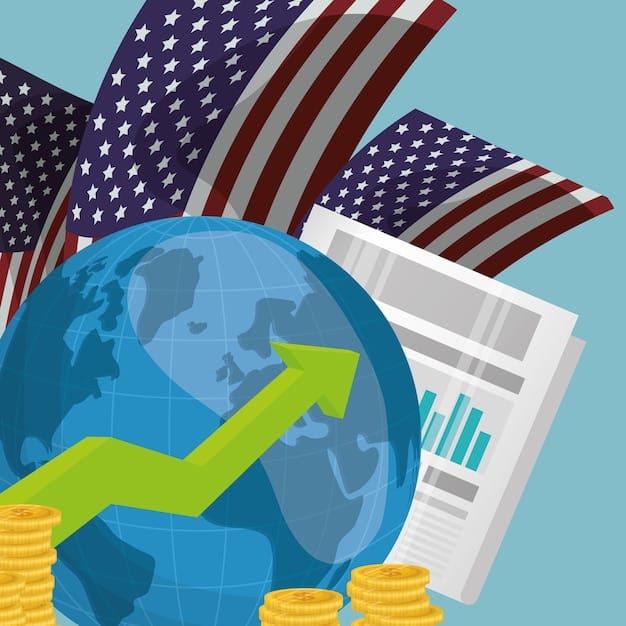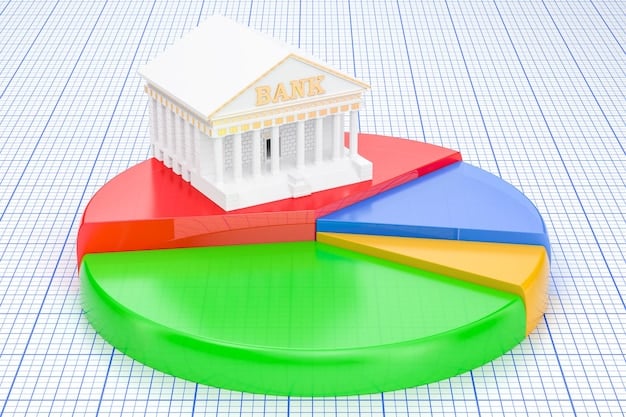15% Corporate Tax Rate: Impact on 2025 Policy Debates

The proposed 15% corporate tax rate is poised to significantly reshape public policy debates in 2025, influencing discussions on economic growth, income inequality, government revenue, and the competitiveness of American businesses on a global scale, potentially leading to revamped fiscal strategies.
Navigating the complexities of corporate tax rates is crucial, especially as discussions intensify about the potential adoption of a 15% rate. Let’s delve into how will the proposed 15% corporate tax rate impact public policy debates in 2025?
Understanding the Corporate Tax Rate Landscape
The corporate tax rate is a percentage of profits a company pays to the government. This rate often becomes a pivotal point in public policy, influencing corporate decisions, investments, and overall economic health. Understanding the current landscape is essential before projecting how a proposed change may impact future debates.
Current US Corporate Tax Rate
As of now, the US federal corporate tax rate is 21%. This rate was set by the Tax Cuts and Jobs Act of 2017, a significant revision from the pre-2017 rate of 35%. This change triggered diverse reactions, with proponents arguing it would stimulate the economy and opponents fearing increased national debt.
Historical Perspective of Corporate Tax Rates
Historically, the US corporate tax rate has undergone substantial changes. Post World War II, it hovered around 50% before gradually decreasing over the decades. These fluctuations often correlated with specific economic theories, varying political administrations, and the country’s financial urgencies.
- Post-WWII Era: High rates aimed at funding national recovery.
- Reagan Era: Tax cuts as part of supply-side economics.
- 21st Century: Global competition influencing rate reductions.
In conclusion, the corporate tax rate has served as both an economic tool and a political battleground. Shifts in this rate influence discussions around economic growth, wealth distribution, and government revenue.

The Proposed 15% Corporate Tax Rate
The proposed 15% corporate tax rate is creating excitement and apprehension in equal measure. This rate isn’t just a number; it’s a potential lever that can reshape how businesses operate and how the government funds its operations. Let’s examine the details of this proposal and its intended objectives.
Details of the Proposal
The proposal involves reducing the existing corporate tax rate from 21% to 15%. Advocates believe this reduction will incentivize businesses to invest more in the US, creating jobs and stimulating economic growth. However, the plan also includes provisions to address potential tax loopholes and ensure large corporations pay their fair share.
Arguments for and Against the 15% Rate
Proponents argue that a lower tax rate will free up capital, encouraging companies to expand their operations, hire more employees, and increase wages. Critics, however, worry about the impact on government revenue and potential increases in the national debt. They also raise concerns that tax savings may primarily benefit shareholders and executives rather than workers.
- Pro: Stimulates economic growth
- Pro: Attracts international investment
- Con: Reduces government revenue
- Con: Exacerbates income inequality
In summary, the proposed 15% corporate tax rate brings both promise and potential pitfalls. Understanding these arguments is essential for informed public policy debates.
Potential Impacts on Economic Growth
Economic growth is frequently at the heart of discussions about corporate tax rates. A lower rate can theoretically boost investment and productivity, but the actual effects are intensely debated among economists. Let’s explore the potential impacts of the 15% rate on US economic growth.
Investment and Job Creation
One of the main arguments for lowering the corporate tax rate is that it incentivizes businesses to invest more in new projects, equipment, and hiring. Lower tax liabilities mean more available capital for reinvestment, potentially leading to increased job creation and higher wages.
Productivity and Innovation
Reduced tax rates can also stimulate innovation by providing companies with more resources to invest in research and development. This can lead to new products, services, and technologies, ultimately boosting productivity and driving economic growth.
The relationship between tax rates and economic growth is multifaceted. Tax cuts may spur immediate growth but can also lead to long-term debt issues. These factors must be carefully weighed in the public policy arena.

Effects on Government Revenue and Public Services
The impact of a 15% corporate tax rate on government revenue is a critical aspect of the discussion. Fewer tax dollars could mean changes in funding for vital public services. Let’s delve into how this rate could affect government revenue and public service allocations.
Projected Revenue Changes
Economists have varying projections on how a 15% corporate tax rate would affect government revenue. Some predict a substantial decrease, while others argue that increased economic activity could offset the lower rate. These projections often depend on different assumptions about economic behavior and tax policy effectiveness.
Impact on Public Services
A significant decrease in government revenue could lead to cuts in public services such as education, healthcare, infrastructure, and social welfare programs. Policymakers might have to make tough choices about which programs to prioritize and how to fund them adequately.
- Education: Potential cuts in school funding
- Healthcare: Reduced access to medical services
- Infrastructure: Delayed or cancelled projects
In conclusion, the fiscal consequences of a 15% corporate tax rate would require careful planning and potentially difficult trade-offs. Policymakers will need to consider the broader fiscal implications for the nation.
Influence on Income Inequality
Income inequality is a recurring theme in debates around corporate tax rates. Lowering the corporate tax rate can disproportionately benefit wealthier individuals, potentially widening the gap between the rich and the poor. Let’s investigate how a 15% rate might influence income inequality.
Distribution of Tax Benefits
Critics argue that tax cuts primarily benefit shareholders and executives who tend to be wealthier individuals. This can exacerbate existing income inequalities, leading to social and economic disparities. The benefits might not trickle down to lower-income workers.
Potential Offsetting Policies
To mitigate the effect on income inequality, policymakers could implement offsetting policies such as increased taxes on high-income earners or expanded social safety net programs. These measures aim to redistribute wealth and provide more support for low-income individuals and families.
The fairness of tax policy is often subjective. Balancing the needs of businesses with the welfare of the population requires careful consideration.
International Competitiveness and Tax Havens
In an increasingly globalized world, corporate tax rates play a crucial role in international competitiveness. Companies may choose to locate their operations in countries with lower tax rates, impacting the US economy. Let’s analyze the implications of a 15% rate on international competitiveness and the use of tax havens.
Attracting and Retaining Businesses
A lower corporate tax rate can make the US more attractive to multinational corporations. This can encourage foreign companies to invest in the US and also help retain American businesses that might otherwise move their operations overseas.
Addressing Tax Avoidance
To ensure fairness and prevent tax avoidance, policymakers need to address loopholes that allow companies to shift profits to tax havens. Implementing stricter regulations and international tax agreements can help curb tax avoidance and ensure companies pay their fair share regardless of where they operate.
- Regulations: Stricter rules on profit shifting
- Agreements: International cooperation to close loopholes
Balancing competitiveness with fairness is a challenge for governments worldwide. Tax policy must adapt to ever-changing global dynamics.
| Key Point | Brief Description |
|---|---|
| 📈 Economic Growth | Lower taxes could stimulate investment and job creation. |
| 💰 Government Revenue | Potential decrease in revenue affecting public services. |
| ⚖️ Income Inequality | Tax benefits could disproportionately favor the wealthy. |
| 🌍 Global Competition | US competitiveness impacted by tax rate compared to other nations. |
Frequently Asked Questions
▼
The current US federal corporate tax rate stands at 21%. This rate was established by the Tax Cuts and Jobs Act of 2017, marking a significant shift from the previous rate of 35%.
▼
A 15% corporate tax rate could spur job creation by freeing up capital for businesses. With more funds available, companies may invest in expansion, new projects, and additional hiring.
▼
Potential downsides include reduced government revenue, which could lead to cuts in public services. There are also concerns that it may exacerbate income inequality, benefiting primarily shareholders and executives.
▼
Corporate tax rates significantly affect international competitiveness. Lower rates can attract and retain multinational corporations, fostering investment in the US. This helps in competing with other nations’ economic environments.
▼
Policies such as increased taxes on high-income earners and expanded social safety net programs can offset inequalities. These measures redistribute wealth and provide more support for low-income individuals and families.
Conclusion
The proposed 15% corporate tax rate presents a multifaceted public policy challenge for 2025. Understanding its potential impacts on economic growth, government revenue, income inequality, and international competitiveness is crucial for informed public discourse and effective policymaking. As the US navigates these complex economic issues, careful consideration of all factors is essential.





